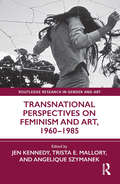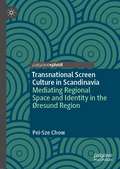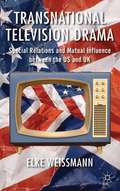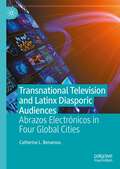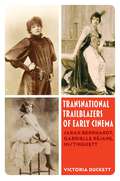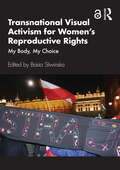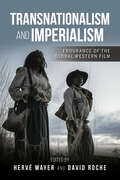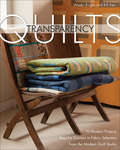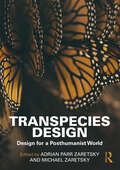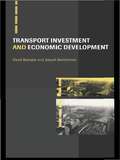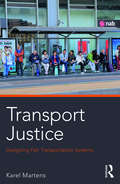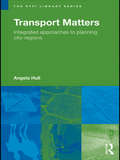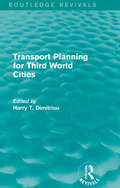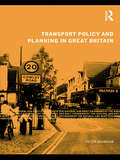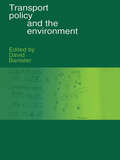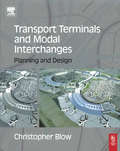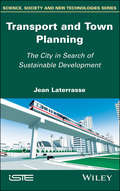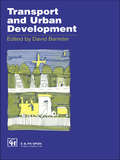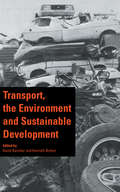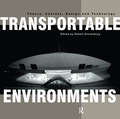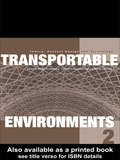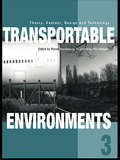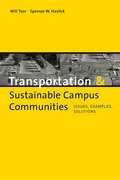- Table View
- List View
Transnational Perspectives on Feminism and Art, 1960-1985 (Routledge Research in Gender and Art)
by Jen KennedyTransnational Perspecives on Feminism and Art, 1960–1985 is a collection of essential essays that bring transnational feminist praxis into conversation with histories of feminist art in the 1960s, 1970s, and early 1980s. The artistic practices and processes examined within these pages all centre on gender and sexual politics as they variously intersect with race, class, sovereignty, Indigeneity, citizenship, and migration at particular historical moments and within specific geopolitical contexts. The book’s central premise is that reconsidering this period from transnational feminist perspectives will enable new thinking about the critical commonalities and differences across heterogeneous and geographically dispersed practices that have contributed to the complex and multifaceted relationship between feminism and art today. The book will be of interest to scholars working in art history, cultural studies, visual culture, material culture, and gender studies.
Transnational Screen Culture in Scandinavia: Mediating Regional Space and Identity in the Øresund Region (Palgrave European Film and Media Studies)
by Pei-Sze ChowThis book explores a range of lesser-known documentaries and short films from the transnational Øresund region released in the period 2000–2009, focusing on how this Scandinavian region’s urban and maritime spaces, iconic architecture, and peripheral communities across Malmö and Copenhagen have been imagined and critiqued through film. This is the first book to widen the critical gaze beyond popular representations to examine a significant body of peripheral films produced in and about the metropolitan Øresund region. Emerging at a time of spatial transformation and geopolitical change, these films weave alternative narratives that confront the official rhetoric of transnational regionalism. Offering the concept of regioscape as a way to investigate the intimate relationship between artistic representation, screen policy, space, and the region-building project, this book presents new readings of films by contemporary Swedish and Danish filmmakers such as Fredrik Gertten, Kolbjörn Guwallius, Daniel Dencik, and Max Kestner.
Transnational Television Drama
by Elke WeissmannThis history of British and American television drama since 1970 charts the increased transnationalisation of the two production systems. From The Forsyte Saga to Roots to Episodes , it highlights the close relationship that drives innovation and quality on both sides of the Atlantic.
Transnational Television and Latinx Diasporic Audiences: Abrazos Electrónicos in Four Global Cities
by Catherine L. BenamouThis book is based on a mixed-method, longitudinal study of the transmission, production, and reception of Spanish- and Portuguese-language television in four global cities with expanding Latinx diasporic populations. The author tracks and analyzes the production practices of Spanish-language broadcasters, the highlights of news and cultural affairs coverage, changes in the shooting locations and sociocultural discourses of telenovelas (both imported from Latin America and domestically produced), the presence of SLTV in the national political sphere, and the modes of media access and opinions of over 400 viewers in Detroit, Los Angeles, Miami, and Madrid. The possibilities created by SLTV and PLTV for achieving a sense of enfranchisement are explored. Intended for a general, as well as academic reading audience.
Transnational Trailblazers of Early Cinema: Sarah Bernhardt, Gabrielle Réjane, Mistinguett (Cinema Cultures in Contact #5)
by Prof. Victoria Harriet DuckettA free ebook version of this title is available through Luminos, University of California Press’s Open Access publishing program. Visit www.luminosoa.org to learn more. At the forefront of the entertainment industries of the late nineteenth and early twentieth centuries were singular actors: Sarah Bernhardt, Gabrielle Réjane, and Mistinguett. Talented and formidable women with global ambitions, these performers forged connections with audiences across the world while pioneering the use of film and theatrics to gain international renown. Transnational Trailblazers of Early Cinema traces how these women emerged from the Parisian periphery to become world-famous stars. Building upon extensive archival research in France, England, and the United States, Victoria Duckett argues that, through intrepid business prowess and the use of early multimedia to cultivate their celebrity image, these three artists strengthened ties between countries, continents, and cultures during pivotal years of change.
Transnational Visual Activism for Women’s Reproductive Rights: My Body, My Choice
by Basia SliwinskaFocusing on art practices that advocate, raise consciousness, and educate about the human right to reproductive health, this book analyses and compares forms of feminist artivism to interrogate bodily rights while closely examining the lived experiences of women and their right of free choice.The transnational framing engages with resurgent imperialist and colonial ambitions across global politics and with the attempts at disrupting these positionings by prioritising feminist care as instrumental for democracy and social justice. Key foci of this book include the ways in which arts activism operates, and its strategies and methods related to, for example, the types of artistic practice employed, approaches to dissemination and reach, and engaging the public. The analysis of these topics interrogates the potential of arts activism to work while other forms of activism may stumble, leading social change in thinking, practice and, finally, legislation. Countries covered include Finland, Poland, Portugal, Latvia, the United Kingdom, Chile, Brazil, the United States, and Australia.The book will be of interest to students and scholars studying art history, art theory and practice, gender studies, and women’s studies.Chapters 2 and 3 of this book are freely available as a downloadable Open Access PDF at http://www.taylorfrancis.com under a Creative Commons Attribution-Non Commercial-No Derivatives (CC-BY-NC-ND) 4.0 license.Chapter 4 of this book is freely available as a downloadable Open Access PDF at http://www.taylorfrancis.com under a Creative Commons Attribution (CC-BY) 4.0 license.
Transnationalism and Imperialism: Endurance of the Global Western Film (New Directions in National Cinemas)
by David Roche Hervé MayerWhile Western films can be seen as a mode of American exceptionalism, they have also become a global genre. Around the world, Westerns exemplify colonial cinema, driven by the exploration of racial and gender hierarchies and the progress and violence shaped by imperialism.Transnationalism and Imperialism: Endurance of the Global Western Film traces the Western from the silent era to present day as the genre has circulated the world. Contributors examine the reception and production of American Westerns outside the US alongside the transnational aspects of American productions, and they consider the work of minority directors who use the genre to interrogate a visual history of oppression. By viewing Western films through a transnational lens and focusing on the reinterpretations, appropriations, and parallel developments of the genre outside the US, editors Hervé Mayer and David Roche contribute to a growing body of literature that debunks the pervasive correlation between the genre and American identity.Perfect for media studies and political science, Transnationalism and Imperialism reveals that Western films are more than cowboys; they are a critical intersection where issues of power and coloniality are negotiated.
Transnationalism, Activism, Art
by Kit Dobson Aine McglynnBanksy is known worldwide for his politically subversive works of art, but he is far from the only artist whose creations are infused with internationally relevant, activist themes. How else can the arts help activate citizen participation in social justice movements? Moreover, what is the role of culture in a globalizing world?Transnationalism, Activism, Art goes beyond Banksy by investigating how the three complementary political, social, and cultural phenomena listed in the title interact in the twenty-first century. Renowned and emerging critics use current theory on cultural production and politics to illuminate case studies of various media, including film, literature, visual art, and performance, in their multiple manifestations, from electronic dance music to Wikileaks to bestselling poetry collections. By addressing how these artistic media are used to enact citizen participation in social justice movements, the volume makes important connections between such participation and scholarly study of globalization and transnationalism.
Transparency Quilts: 10 Modern Projects; Keys for Success in Fabric Selection from the Modern Quilts Studio
by Weeks Ringle Bill KerrThis follow-up to Quilts Made Modern delivers &“a unique lesson in applying color theory to fabrics, patterns and quilts&” (Portland Modern Quilting Guild).Learn how to use traditional piecing techniques to create quilts with layered translucent effects from the husband-and-wife team behind Modern Quilt Studio. By distinguishing and balancing the subtleties of color in your fabrics, you can achieve remarkable results. Discover how the visual relationships between different colors make all the difference in your quilts.· Master the illusion of transparency with ten quilt projects, each with instructions for three sizes—wall, lap, and bed.· Design experts Ringle and Kerr show you how to select fabrics for striking, modern results.· These quilts have sophisticated style with a soft, graphic look to update any home décor.&“Patterns replicating tartan and madras are most effective. The couple&’s writing style is practical, edged a bit with cutesy.&” —Publishers Weekly &“Color is the main event—and the technique using color in Transparency Quilts is quite magical . . . if you are an adventurous beginner or above—these quilts will give you a new way of thinking about and using color that you might just love.&” —Daisy and Jack (One Stitch at a Time)
Transpecies Design: Design for a Posthumanist World
by Michael Zaretsky Adrian Parr ZaretskyIn May 2019, the United Nations released the Global Assessment Report on Biodiversity and Ecosystem Services which warned that human activities will drive nearly one million species to extinction in a few decades. The primary reasons for this are habitat loss and biodiversity demise caused by changing climate, pollution, introducing nonindigenous species, clearing land, over population, and consumption. Given this situation, humans must change course as both human wellbeing and the wellbeing of other-than-human species are imbricated in one another. One way humanity can accomplish the needed transformation is to move beyond an anthropocentric view of life by embracing a transpecies approach that is premised upon interconnected flourishing.Transpecies design, as outlined in this book, offers a new approach to regenerating the natural environment while honoring biodiversity. Rather than presenting the human experience as the goal of design, transpecies design takes the inextricable linkages connecting living things as both its starting point and end goal. As such, it moves beyond human experience serving as the fundamental ingredient for making better design processes and decisions.This book is essential reading for artists, designers, and architects, as well as students of architecture, landscape architecture, interior architecture, art, product design, urban design, planning, environmental philosophy, and cultural studies.
Transport Investment and Economic Development
by Joseph Berechman David BanisterA major concern of all decision makers has been to ensure that there are clear benefits from transport investment proposals. The travel time savings are clear, but the wider economic developments have presented enormous difficulty in terms of both theoretical arguments and empirical evidence. This book reviews the history of the debate and argues that the agenda has changed.These issues are presented together with a major analytical investigation of macroeconomic models, evaluation in transport and microeconomic approaches. The final part of the book presents a series of case studies for road, rail and airport investment schemes, particularly focusing on the economic development aspects.
Transport Justice: Designing fair transportation systems
by Karel MartensTransport Justice develops a new paradigm for transportation planning based on principles of justice. Author Karel Martens starts from the observation that for the last fifty years the focus of transportation planning and policy has been on the performance of the transport system and ways to improve it, without much attention being paid to the persons actually using – or failing to use – that transport system. There are far-reaching consequences of this approach, with some enjoying the fruits of the improvements in the transport system, while others have experienced a substantial deterioration in their situation. The growing body of academic evidence on the resulting disparities in mobility and accessibility, have been paralleled by increasingly vocal calls for policy changes to address the inequities that have developed over time. Drawing on philosophies of social justice, Transport Justice argues that governments have the fundamental duty of providing virtually every person with adequate transportation and thus of mitigating the social disparities that have been created over the past decades. Critical reading for transport planners and students of transportation planning, this book develops a new approach to transportation planning that takes people as its starting point, and justice as its end.
Transport Matters: Integrated Approaches to Planning City-Regions (RTPI Library Series)
by Angela HullAddressing the principles of sustainability, spatial planning, integration, governance and accessibility of transport, this book focuses on the problem of providing efficient and low energy transport systems which serve the needs of everybody. It explores many of the new arguments, ideas and perceptions of mobility and accessibility in city-regions. Looking at evidence from Denmark, Sweden, The Netherlands, Germany and the UK, it considers the meaning of the key concepts of sustainable accessibility, the spatial planning model, and integrated territorial policies.
Transport Planning for Third World Cities (Routledge Revivals)
by Harry T. DimitriouCities within the developing world experience a form of urban development which is different to those in more industrialised countries. Rates of growth are usually much more dramatic, housing and transport are often provided informally, and institutional support for urban management is also much weaker. The crux of this book, first published in 1990, lies in the idea that urban transport planning cannot be viewed in isolation from this wider development context. Making special reference to a number of countries, including Brazil, India and Indonesia, chapters discuss problems of urban transport planning, deficiencies in the theory and practice of conventional transport planning, and the emerging alternatives in the countries under examination. This work addresses problems that are still of great concern to urban policy planners, professionals and academics, as well as students from the fields of development studies, urban geography and planning, architecture and civil engineering.
Transport Policy and Planning in Great Britain (Natural and Built Environment Series #Vol. 5)
by Peter HeadicarTransport in the twenty-first century represents a significant challenge at the global and the local scale. Aided by over sixty clear illustrations, Peter Headicar disentangles this complex, modern issue in five parts, offering critical insights into: the nature of transport the evolution of policy and planning policy instruments planning procedures the contemporary agenda. Distinctive features include the links forged throughout between transport and spatial planning, which are often neglected. Designed as an essential text for transport planning students and as a source of reference for planning practitioners, it also furthers understanding of related fields such as urban and regional planning, geography, environmental studies and public policy. Based in the postgraduate course the author developed at Oxford Brookes University, this indispensable text draws on a lifetime of professional experience in the field.
Transport Policy and the Environment
by David BanisterThere is currently considerable concern with limiting the growth of transport demand, the use of resources and related pollution. This book makes a major contribution to the debate on transport and the environment and is likely to become a benchmark against which new research will be developed. Transport Policy and the Environment presents for the first time the results of extensive research: *quantifying the contribution of transport to environmental problems. *assessing the options for resolving those problems. *investigating the conflicts arising from policy implementation. *developing new and better methods of data collection and analysis. It brings together the results of a major research programme funded by the UK Economic and Social Research Council on Transport and the Environment and provides a clear view on current policy. It is the major contribution that UK research has made to the debate and provides the first set of substantive results on the effectiveness of policy, and the means by which the impact can be measured and assessed.
Transport Terminals and Modal Interchanges: Planning And Design
by Christopher BlowThis is the first book to review a trend in transport systems which has only recently come of age: the multi-modal interchange. Separate modes of transport are being linked through 'joined-up thinking', and transport designers and authorities are only now able to exploit interchange opportunities. This book presents examples of how these new opportunities have been planned and designed, and outlines how transfer and mobility can be improved in the future. Blow takes the airport as the focal point of true multi-modal passenger terminals and presents the development of these buildings as representing a new experience in travel. The book shows that the success of the experience of transferring from one mode of transport to another depends on the many factors, including congestion in an already overloaded system, and the way that designers and managers have addressed contingency planning. International examples are drawn from areas where mobility is most concentrated and the demands on design are at their highest. The book also addresses important issues of rebuilding and redevelopment, where once separate modes of transport are being linked to each other, and where short-term inconveniences rectify past wrongs in the long term. It is a compendium of architectural and engineering achievement.
Transport and Town Planning: The City in Search of Sustainable Development
by Jean LaterrasseIn a context where climate change urgently requires us to alter our paradigms, this book explores the possibilities of cities that are both more energy efficient and more respectful of the environment. Based on the observation that urban planning has been detrimentally affected by the compartmentalization of knowledge and practices, this book is conceived as a dialog between transport and urban planning on the one hand, and between engineering and social science on the other. Systemic analysis and a historical approach, integrating the teachings of the last two centuries, constitute at the methodological level the framework in which this dialog unfolds. Based on examples of good practice, Transport and Town Planning identifies an effective set of levers of action and proposes an original method to guide and accompany urban transition with a large share of the initiative reserved for the actors concerned.
Transport and Urban Development
by David BanisterThe editor and his contributors take an international perspective on the links between land use, development and transport and present the latest thinking, the theory and practice of these links. Authors from six countries - all experts in this area - have been commissioned to write chapters on the theoretical debates and more practical issues, via the use of detailed case studies.
Transport, the Environment and Sustainable Development
by D. Banister K. ButtonThis book presents the current thinking from leading authorities worldwide on transport and the environment and focuses on the link between transport supply and use and environmental degradation.
Transportable Environments
by Robert KronenburgTransportable Environments explores aspects of the historical and theoretical basis for portable architecture and provides an insight into the wide range of functions that it is used for today, the varied forms that it takes and the concerns and ideas for its future development. Written by a team of international commentators, this volume provides a state-of-the-art survey of this specialist area and will be of interest to a wide range of professionals across the construction and design industries.
Transportable Environments 2
by Robert Kronenburg Joseph Lim Wong Yunn ChiiThis book explores aspects of the historical and theoretical basis for temporary and transportable environments and provides an insight into the wide range of functions that they are used for today, the varied forms they take and the concerns and ideas for their future development. Themes in the book range from wide-ranging topical issues like the ecological implications of building to more focused investigations such as shelter after disaster. The book will be of interest to both students and practising architects, engineers and those involved in the creation of the built environment. It will also be of value to those involved in areas of product design, design history, building component manufacture and urban design.
Transportable Environments 3
by Robert Kronenburg Filiz KlassenThe latest volume in this popular series of books which explores the theoretical basis for temporary and transportable structures where permanence is either not possible or desirable. The book provides insight into the wide range of uses of these structures, the varied forms they take and the concerns and ideas for future development, focusing on portability, adaptability, sustainability of the built environment, and technical innovations. A wide range of designed solutions identify and define contemporary directions in design theory and practice. With international examples throughout, this book will be of interest and value to all those involved in the areas of building design, building component manufacture and urban design.
Transportation & Land Use Innovations: When you can't pave your way out of congestion
by Reid EwingFirst published in 1997. Routledge is an imprint of Taylor & Francis, an informa company. This handbook introduces community leaders to an understanding of transportation mobility, offering suggestions to reduce congestion, automobile dependence, and vehicle miles of travel.
Transportation and Sustainable Campus Communities: Issues, Examples, Solutions
by Spenser Havlick Will ToorColleges and universities across North America are facing difficult questions about automobile use and transportation. Lack of land for new parking lots and the desire to preserve air quality are but a few of the factors leading institutions toward a new vision based upon expanded transit access, better bicycle and pedestrian facilities, and incentives that encourage less driving. Transportation and Sustainable Campus Communities presents a comprehensive examination of techniques available to manage transportation in campus communities. Authors Will Toor and Spenser W. Havlick give readers the understanding they need to develop alternatives to single-occupancy vehicles, and sets forth a series of case studies that show how transportation demand management programs have worked in a variety of campus communities, ranging from small towns to large cities. The case studies in Transportation and Sustainable Campus Communities highlight what works and what doesn't, as well as describing the programmatic and financial aspects involved. No other book has surveyed the topic and produced viable options for reducing the parking, pollution, land use, and traffic problems that are created by an over-reliance on automobiles by students, faculty, and staff. Transportation and Sustainable Campus Communities is a unique source of information and ideas for anyone concerned with transportation planning and related issues.
